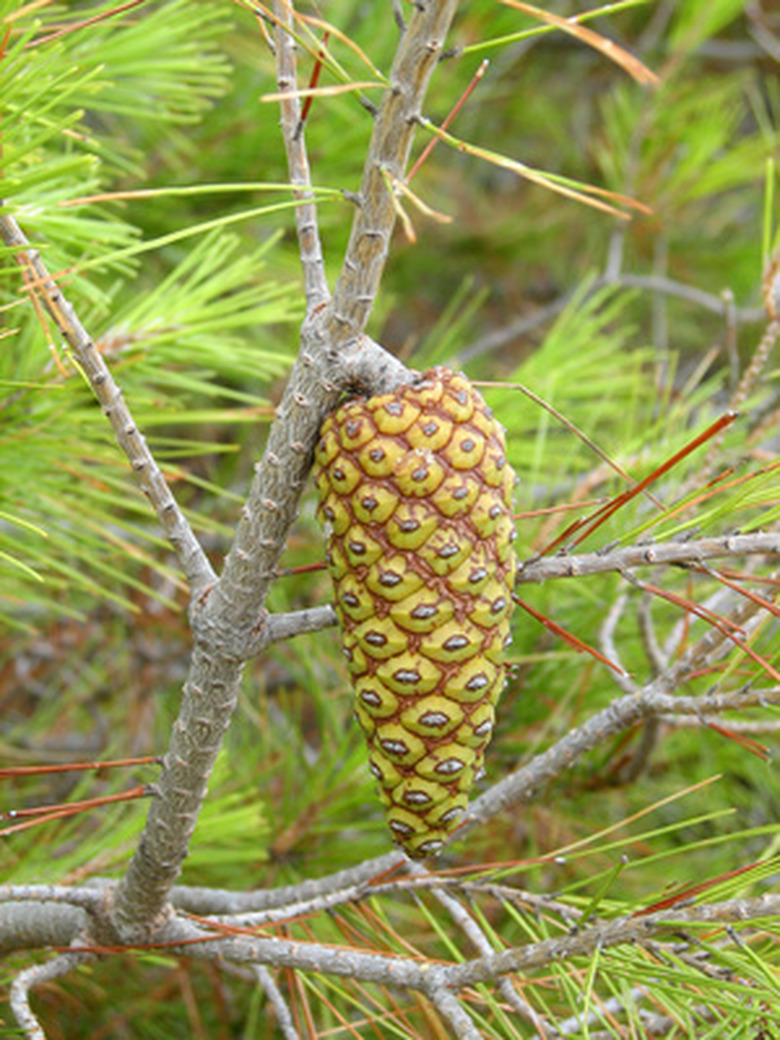Life Cycle Of A Non-Flowering Plant
Of the myriad plants observable in your backyard, flowering plants are probably the most familiar, representing the dominant and most successful plants on Earth. But the moss growing underfoot, the fern nodding in the shadows of the trees and the tall, silent conifer–all non-flowering plants–have survived as well, each with its own distinct life cycle marking different steps on the path of plant evolution.
Evolution
Evolutionarily, plants have proceeded from relatively simple and small, increasing in complexity until culminating in the flowering plants you can observe today. Plants originated in the water as single-celled organisms or relatively simple clumps of cells similar to algae. When they moved onto land, having each cell near a source of water and nutrients kept them small: the mosses. When vascular tissue developed, water and nutrients could be conducted longer distances, from roots to the tips of leaves, and ferns developed. Improvements in water-based spore reproduction led to the first seeds. Non-flowering seed plants today are called gymnosperms and include conifers and palm trees. Gymnosperms, in turn, evolved into the angiosperms, or flowering plants.
- Of the myriad plants observable in your backyard, flowering plants are probably the most familiar, representing the dominant and most successful plants on Earth.
- But the moss growing underfoot, the fern nodding in the shadows of the trees and the tall, silent conifer–all non-flowering plants–have survived as well, each with its own distinct life cycle marking different steps on the path of plant evolution.
Types
These four loose groupings–mosses, ferns, gymnosperms and angiosperms–provide a classification scheme that botanists use today. Of these four types, all but angiosperms are non-flowering, flowers having developed relatively recently on the evolutionary timeline. Mosses contain no vascular tissue and reproduce using spores. Ferns also reproduce with spores, but a primitive vascular system allows for the transport of nutrients. Gymnosperms improved reproduction with the development of the seed, removing the need for water to reproduce and contributing extra protection to the plant embryo. All three types of non-flowering plants have slightly different life cycles.
Mosses
Mosses are distinctive among plants because theirs is the only life cycle where the visible plant is haploid, containing only half the expected number of chromosomes. The plant develops shoots, female and male, and eggs and sperm form at the tips. When rain falls, water carries the sperm to the egg, and the resulting fusion produces a complete set of chromosomes called a sporophyte. The sporophyte develops into stalk, and the cells at the tip divide until they have only half the number of chromosomes again. The wind carries these spores to new locations, where they divide and develop into new mosses.
- These four loose groupings–mosses, ferns, gymnosperms and angiosperms–provide a classification scheme that botanists use today.
- Gymnosperms improved reproduction with the development of the seed, removing the need for water to reproduce and contributing extra protection to the plant embryo.
Ferns
Unlike mosses, the plants people recognize as ferns have the expected number of chromosomes. Structures called sori or fruit dots form on the undersides of the leaves, the cells dividing until they have only half the number of chromosomes. Caught by the wind, if the spore lands in a suitable location, it will develop into a structure called a prothallus. The prothallus produces eggs and sperm, and like the mosses, water carries the sperm fertilize the egg. The resulting gamete replicates, forming a fern plant.
Gymnosperms
The need for water to transport their sex cells left the reproduction of mosses and ferns somewhat in the hands of chance, and of millions of spores produced, only one might be successful in establishing a new plant. Gymnosperms developed seeds and pollen, which could be carried by the wind. Gymnosperms produce male and female sex cells on cone-like structures–the familiar pine cone contains the female cells and seeds. Male cones form pollen that, borne on the wind, lands on female cones, fertilizing the eggs inside the seeds. When the cones drop to the ground, the seeds germinate into new plants.
- Unlike mosses, the plants people recognize as ferns have the expected number of chromosomes.
- The prothallus produces eggs and sperm, and like the mosses, water carries the sperm fertilize the egg.
